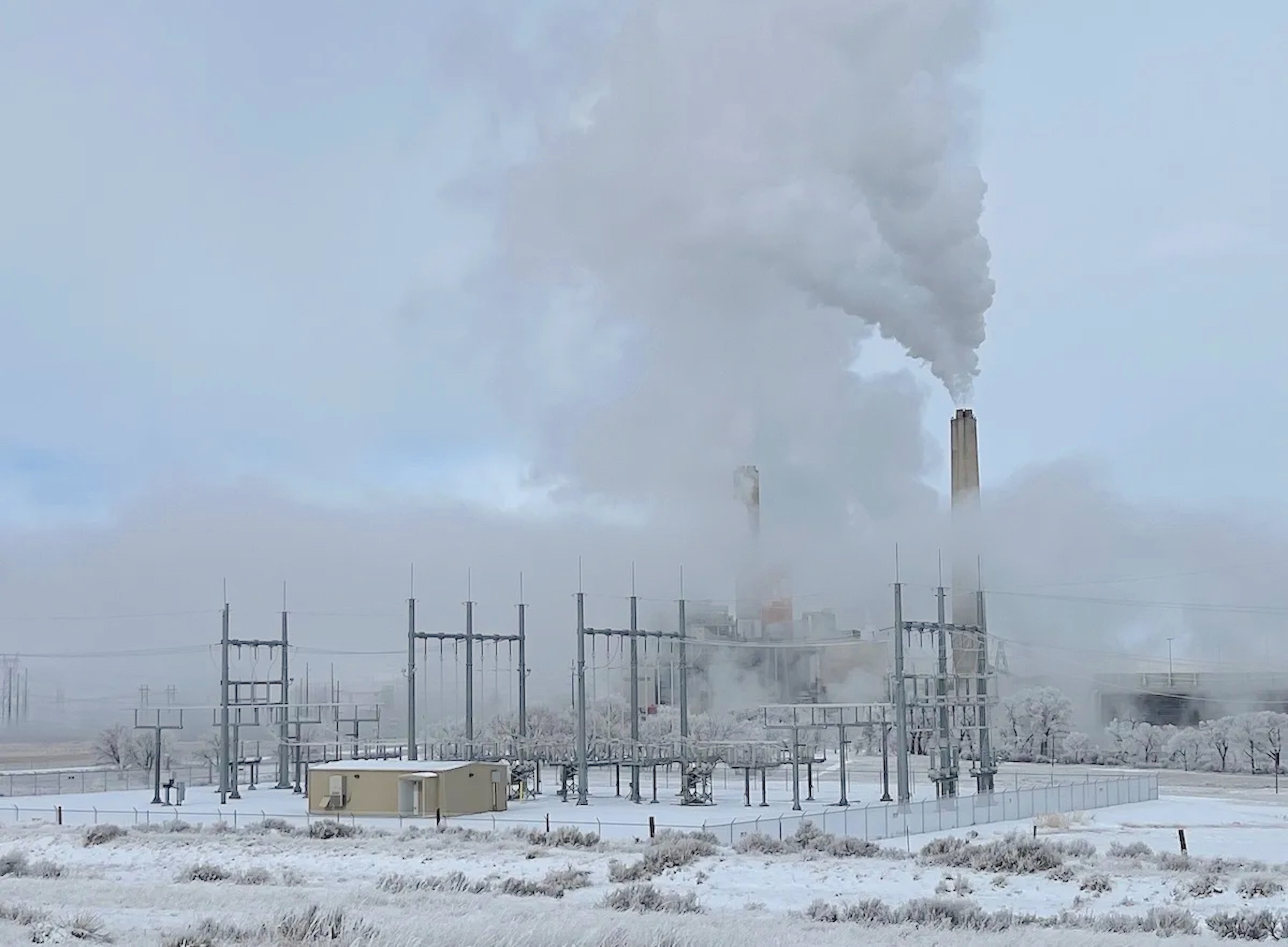PacifiCorp throws lifeline to one Wyoming power plant, confirms end of coal at another

• Utility’s moves will result in more planet-warming emissions and higher electric bills, critics say.
By Dustin Bleizeffer, WyoFile.com
Wyoming’s largest electric utility has thrown a temporary lifeline to the Dave Johnston coal-fired power plant near Glenrock while solidifying plans to stop burning coal at the Naughton power plant near Kemmerer by the end of this year.
The move is welcomed news in Converse County, according to Commission Chairman Jim Willox, noting the Dave Johnston plant employs hundreds of locals. It’s a “scary” proposition in Kemmerer, where the fate of the Naughton plant may foreshadow the viability of the Naughton coal mine, which employs nearly 200 people.
Overall, PacifiCorp, parent company of Rocky Mountain Power, has made a dramatic shift from previous plans to vastly dial back its reliance on coal while fast-tracking investments in renewable energy, according to its final 2025 Integrated Resource Plan — an expansive two-volume document — published earlier this week. The changes, according to PacifiCorp and many observers, come as a response to President Donald Trump’s sweeping rollbacks of fossil fuel regulations and Biden-era climate and renewable energy initiatives.
PacifiCorp, which operates in six western states, including Wyoming, admits that its revised plans will increase reliance on natural gas — a commodity prone to volatile price swings — and more emissions of planet-warming greenhouse gases.
Ultimately, the plan reflects the Trump administration shifting say over industrial emissions from the federal government to the states, according to some utility industry analysts. In fact, one major change with the plan — which is a nonbinding “roadmap” for how it will generate and acquire electrical power for the next 20 years and is updated every two years — is PacifiCorp’s move to dedicate specific power sources to specific states.
For example, the company is directing more renewable power sources to its Washington and Oregon service territories because those states have enforceable renewable energy portfolios.
In fact, PacifiCorp — prompted by Utah lawmakers — has mulled a breakup to serve individual states in its service territory specific to their preferred sources of power generation.
It’s a move that Wyoming leaders have championed for years, though many conservation and ratepayer advocacy groups warn it will lead to higher electric bills here, and a dirtier environment beyond. PacifiCorp, part of billionaire Warren Buffett’s Berkshire Hathaway, operates some of the dirtiest coal plants in America, according to a recent Reuters analysis.
“Instead of prioritizing cost-effective, job-creating renewable energy, the utility is doubling down on expensive fossil fuels, speculative carbon capture technology and a nuclear plant — all while ratepayers foot the bill,” Sierra Club of Wyoming Energy Organizer Emma Jones said.
What’s in the plan for Wyoming
Rather than fully retiring two of four coal-burning units at the Dave Johnston power plant in 2028, the utility now plans to convert those units to natural gas in 2029 and continue their operation. A third coal unit at Dave Johnston will be shut down in 2027, as previously planned, and the fourth, which had no retirement date, will now be converted to natural gas in 2030.
The company’s plans for the Jim Bridger power plant east of Rock Springs and the Naughton plant near Kemmerer didn’t change.
Two of four coal units at Jim Bridger were converted to natural gas last year, and the company still plans to retrofit the other two units there with carbon capture technology by 2030 or 2032, to comply with a Wyoming mandate.
At Naughton, the first of three coal units was converted to natural gas in 2020. PacifiCorp confirmed this week it still plans to take the two remaining coal units offline by the end of this year and resume operating them on natural gas in 2026 — a commitment also reflected in a November filing with the Wyoming Public Service Commission.
The switch away from coal there, according to PacifiCorp, is due to a determination that “natural gas conversion of Naughton units 1 and 2 was the least-cost, least-risk option for the company and its customers” and worth the estimated $12.1 million cost to do it, according to previous planning documents.
The future of the Wyodak plant outside Gillette is less clear. The company previously planned to retire the coal plant in 2039. Now, there’s no official retirement date for the plant, PacifiCorp told WyoFile. However, if previous iterations of the Clean Air Act under the Biden administration remain, it would be retired in 2032.
Local officials welcomed the news of a reprieve for some coal plants in the state, even though many will eventually be converted to natural gas. The power plant is responsible for hundreds of jobs, directly and indirectly, according to local officials.
In Converse County, the Dave Johnston power plant has been critical to the local economy, Commission Chairman Jim Willox told WyoFile. “It provides regular, good-paying employment and, even more importantly, baseline power for the western United States,” Wilcox said.
Shifting coal markets
Before Trump’s tariff initiatives this week, there was growing optimism among coal proponents that the U.S. coal market might rebound from recent declines.
Although U.S. coal production is still projected to decline again this year, particularly in the Powder River Basin, the rate of decline is slowing due to increasing electrical demand. Six months ago, the U.S. utility industry planned to retire some 15,600 megawatts of coal-fired power within the next year, according to the coal industry analyst company McCloskey. By March, however, planned coal plant retirements shrank to 12,300 megawatts.
One megawatt is enough electricity to power about 750 homes.
“This is driven by the huge requirements for cloud computing, AI computing, bitcoin mining, cryptocurrency and the ongoing movement to e-commerce and online sales,” McCloskey Associate Director and Research Analyst Dianna Ridgway said in March. “All of this is driving an increase in future [electrical] load growth. As a result, power generators are turning back their previous decisions to retire coal plants.”
However, McCloskey analysts noted, the extension of coal plants is likely to be short-lived simply because the U.S. fleet is already beyond its life expectancy and there are no new coal plants in queue for construction.
“I do believe we’ll see some of these [coal plant] retirements get delayed further,” McCloskey Data Analytics Director Andrew Blumefeld told attendees of a March webinar. “But, ultimately, time is not on the side of the coal units.”
Although PacifiCorp is pushing back coal plant retirement dates, it noted that due to the increasing cost to operate the facilities — many of which are more than 50 years old — it will continue the practice of operating coal plants at less than their rated capacity.
PacifiCorp also still plans to finalize an agreement — perhaps this year, it said — to buy electricity from TerraPower’s Natrium nuclear power plant near Kemmerer. The utility, however, still has not disclosed the potential cost, which would be passed on to ratepayers across multiple states. Natrium’s anticipated construction cost is $4 billion.
Renewable energy
Although PacifiCorp will use slightly more solar energy than called for in its 2023 plan, that power is mostly dedicated to its customers in Oregon and Washington, according to the company.
“Wind is way down across the board,” Sierra Club staff attorney Rose Monahan told WyoFile.
Though the latest plan calls for more than 3,700 megawatts of new wind power generation throughout its six-state service region by 2045, that’s a 59% reduction compared to the company’s previous plan.
PacifiCorp is still moving forward with construction of its $8 billion Gateway interstate electric transmission lines — touted as key to providing “long-term affordability and reliability and helping build a more resilient grid,” according to the company, and essential to meet “significant new data center loads.” That means Wyoming is likely to see the continued expansion of wind energy construction in Wyoming, Monahan said, without reaping all the benefits of that energy.
“This means that Wyoming’s electric rates are still going to be closely tied to fossil fuels,” Monahan said.
She noted that in recent rate hike requests in Wyoming — both for permanent increases and annual fuel cost adjustments — the company has pointed to the increasing costs of operating coal-fired facilities and the volatility of coal and natural gas commodity markets. “Wyoming’s electric rates are still going to be closely tied to fossil fuels, which PacifiCorp acknowledged in the last rate case were far and away the biggest driver of rate increases,” Monahan said.
PacifiCorp’s Rocky Mountain Power recently agreed to trim its most recent Wyoming rate hike request from 14.7% to 10.2%. The Wyoming Public Service Commission is expected to rule on the settlement agreement on April 15.
Why the changes?
Observers, and even PacifiCorp, have noted that the company’s 2025 planning document represents a significant departure from past plans.
“These changes are in response to variables in future customer demand, technology developments, state and federal policy changes and projections of future economics,” PacifiCorp spokesman David Eskelsen told WyoFile via email.
He noted that the planning documents, looking 20 years into the future, continually change and are updated every two years. “Each IRP is a roadmap for the future, based on the most current information we have for modeling and projection.”
In the opening of PacifiCorp’s 2025 plan, it states, “The preferred portfolio is responsive to the rapidly expanding arena of new state and federal regulatory requirements.”
Though prudent to account for those continual changes — or at least try to account for them — Monahan said she believes PacifiCorp’s updated long-term plan relies too heavily on the Trump administration’s influence over the utility industry.
“This administration will not last forever,” Monahan said. “This is a 20-year portfolio. To just assume no changes in environmental policy — it’s just building risk into the portfolio, unnecessarily.”
Further complicating the outlook for electrical utilities — and just about every sector of the nation’s economy — are Trump’s tariffs and global responses to them, which include retaliatory tariffs.
Willox, of Converse County, said industrial businesses in his region — PacifiCorp as well as manufacturers and the oil and natural gas industry — purchase a lot of steel, aluminum and other industrial supplies from “all over.”
“[Tariffs] will have an impact on the energy industry in Converse County,” Willox said. “What that impact is, we don’t know yet.”
WyoFile is an independent nonprofit news organization focused on Wyoming people, places and policy.





